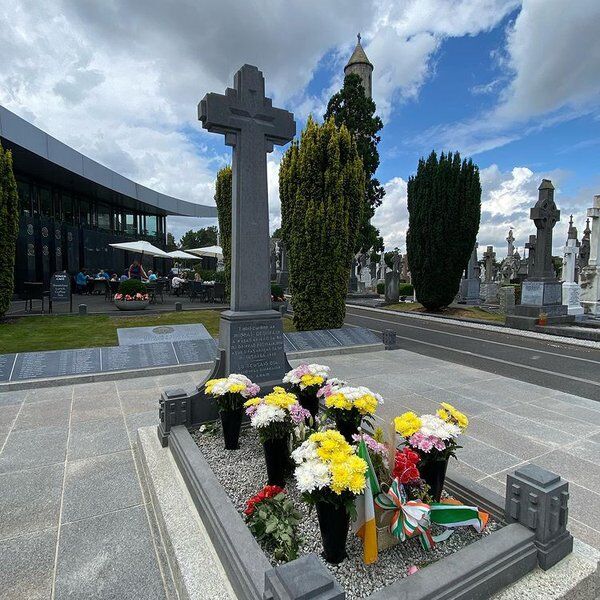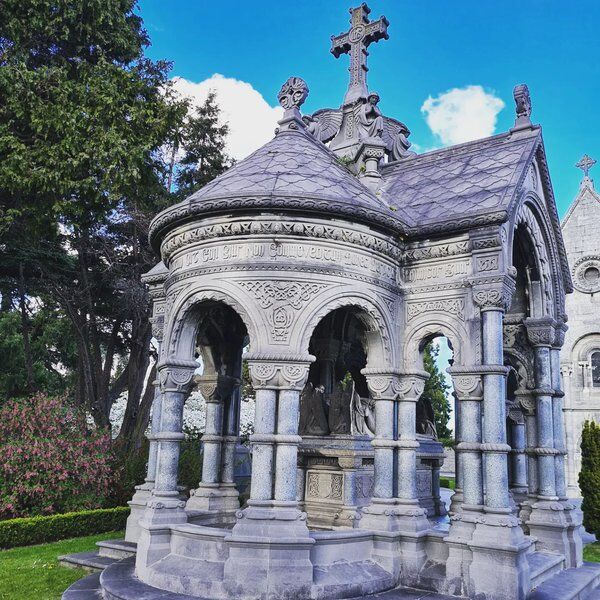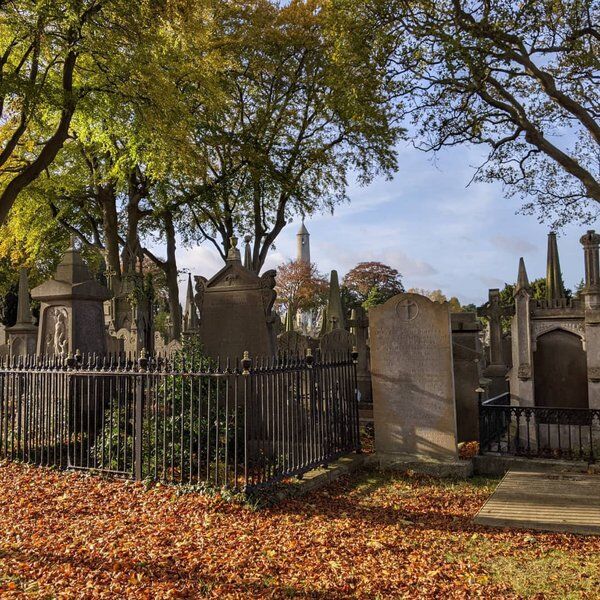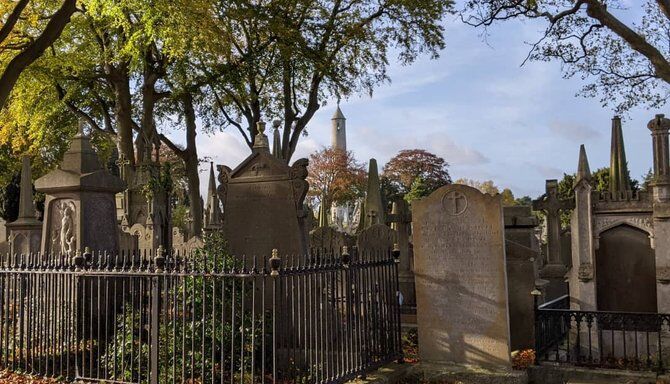
Glasnevin Cemetery opened in 1832 and is the final resting place of around 1.5 million people, many of whom played key roles in shaping Ireland’s history. It is managed by Dublin Cemeteries Trust, who proudly protect and promote the stories of these people — ordinary and extraordinary alike.
Where is Glasnevin Cemetery?
The cemetery is made up of two parts split down the middle by a road and a stretch of greenery. The main part stretches from Finglas to the city centre. The other is between two railway lines and is known as St Paul's.
Over the years it’s traditional Victorian garden style has transformed. It now features modern lawn-style plots, memorial gardens, many infamous monuments, an interactive museum and the Tower Café. Today, the cemetery spans 124 acres, a vast increase from its original 9 acres.

The Historical Significance of Glasnevin Cemetery
Prior to Glasnevin’s establishment, Irish Catholics had no cemeteries of their own. Ireland’s 18th-century Penal Laws, designed to force Irish Catholics and Protestant dissenters to accept the established Church of Ireland, enforced restrictions on many Catholic services. Consequently, it was typical for Catholics to conduct limited funeral services in Protestant graveyards.
This all changed in 1823 when an incident at one of these gatherings, provoked public outcry. Daniel O’Connell, Irish political leader, responded by campaigning for the opening of a new cemetery. In this cemetery both Irish Catholics and Protestants were able to bury their dead with dignity.
Many people felt that Glasnevin should be a Catholic cemetery, but O’Connell said no - arguing that that would be discrimination and exactly what the Protestants did to Catholics, Presbyterians and Methodists.

Glasnevin Cemetery Museum
Opened in 2010, Glasnevin’s Cemetery Museum became the first of its kind in the world. In the museum there are many award-winning exhibits including “The City of the Dead“. This exhibition is an immersive display in the centre’s basement. It allows visitors to experience historical burial practices and customs and discover fascinating stories about the afterlife, from religious cultures worldwide. The Milestone Gallery has displays about the cemetery’s historical figures and a timeline of their lives and relationships. There is also a gift shop and a cafe.

Resting in Peace at Glasnevin Cemetery
Some of the figures that are celebrated in the museum and buried at Glasnevin include; Daniel O’Connell, Michael Collins, Charles Stewart Parnell, Maud Gonne, Eamon de Valera, Countess Markievicz.
At Glasnevin there are also around 800,000 victims of the 1840s Great Famine and a later cholera epidemic. They however lie in unmarked graves.
Other victims of disease are buried in epidemic designated areas. These include plots specific to smallpox, cholera, and typhoid. However, the typhoid area was situated over underground springs, which supplied water to the surrounding neighbourhoods. As a result the disease spread further.

At Glasnevin there is a specific area, the Angel’s Plot, where babies that are born sleeping can be buried. Glasnevin Cemetery is one of the few places that allows stillborn babies to be buried in holy ground.
There is also an area reserved for the ‘fallen women’ of an Irish Magdalene Laundry. In 1993, after the Convent that ran the Laundry was sold, a mass grave was discovered. The Sisters from the Convent had the women’s remains cremated and reburied in a mass grave at Glasnevin Cemetery. They split the costs with the property developer who bought the land.
(To discover more about Magdalene Laundries, why not read our article on Abbotsford Convent.)
Fighting for Ireland’s Freedom
The most popular gravesite is that of Michael Collins, a 20th-century nationalist leader who fought for Irish Independence. Around him are buried at least 183 soldiers of the Irish Free State, which he helped to establish. In 1967 their names were recorded on the memorial near his grave.
Also buried near Collins is his girlfriend Kitty Kiernan and his enemy Éamon de Valera. De Valera served several terms as Head of Government and Head of State and partially wrote the Irish Constitution. However, his role in the Civil War, where he was anti-treaty, makes him “a controversial and divisive figure in Irish history.”

Buried close by is Charles Stewart Parnell, leader of the Irish Parliamentary Party and another vital character in Irish Independence. By the time he died in 1891, he was terribly poor. He had spent all of his money on expensive divorce proceedings, which also halted his political career. Despite this, he remained popular with the Irish public. These supporters convinced Glasnevin Cemetery to bury him, despite the limited funds.
Then, this area was poor ground, and nobody wanted to be buried here… By burying a popular leader in an unpopular part of the cemetery meant those who respected him would want to be buried beside him.
The plan worked and soon the area in which Parnell was buried blossomed in popularity.

Inside Glasnevin Cemetery
Grave Robbing
Visitors may notice the watchtowers and high walls that surround the main part of the grounds. These were erected as a deterrent to grave robbers, who were active in Dublin- alongside Edinburgh and London- in the 18th and early 19th centuries. The watchmen also had a pack of blood-hounds who would roam the cemetery at night.
It used to be illegal to touch a corpse under British law, which ran here at the time… The problem was: doctors needed to dissect bodies so they could understand anatomy. That created a black market for dead bodies. Where could you get a dead body? The graveyard.

With the help of small children, shovels, hammers and rope they would remove dead bodies and sell them to medical schools. Glasnevin's ‘The City of the Dead’ exhibition highlights this grave-robbing phenomenon, as do sections of Edinburgh's Surgeon's Hall Museum.
The O’Connell Tower
Another notable feature in the cemetery is the formidable O’Connell Tower, built to honour Glasnevin’s founder.
The design was based on Celtic round towers, which were bell towers created by monks… This tower is built on top of a mound, shaped as Newgrange — so you have Celtic and Catholic influences together.
In 1971 a Loyalist bomb exploded at the tower’s base. Restoration plans were undertaken in the 1990s and were completed in 2018. At the top of its 198 steps, visitors can take in the breath-taking views of Dublin, Wicklow, Meath, and the Irish Sea.

The World Wars
Elsewhere, the Cross of Sacrifice marks the centenary of WWI and there is a gateway to the beautiful National Botanic Gardens. (As of 2019, the remains of 215 service personnel from both world wars, were identified at Glasnevin Cemetery.)
The Crematorium
In 1982 a crematorium was built within the cemetery grounds, by Glasnevin Trust. Since then, it has been used by people of many different faiths.

What is the best way to explore Glasnevin Cemetery?
One of the best ways to explore the cemetery and discover more about Ireland’s history, is by taking a guided walking tour. All the tour guides are extremely knowledgeable and passionate about Glasnevin, leading visitors around the cemetery with a mindful balance of sensitivity and fun.
General History Tour:
This tour gives an overview of the history of Glasnevin Cemetery and visits the graves of Ireland’s heroes. Visitors can listen to stories of rogues and rebels, the famous and the infamous, gravediggers and grave robbers.
Dead Interesting Tour:
Learn about sculptures, symbolism, architecture, art, natural life and hear stories of the lesser known, but equally interesting personalities buried at Glasnevin. Dead Interesting reveals some of Glasnevin's secrets, such as the story of Maria Higgins, a lady who died once but was buried twice and Francis de Groot, who opened the Sydney Harbour Bridge by accident.
Our thoughts...
Surprisingly, Glasnevin Cemetery is one of Dublin’s most lively spots! There is clearly plenty to appreciate about this historic and tranquil spot built to honour, celebrate, and remember loved ones and the country’s fallen heroes.
Want to learn more about Dublin and see some of it's secret & hidden sights? Check out our Dublin Treasure Hunts, puzzle-filled urban adventures lead you through city highlights and best-kept secrets. You'll actively engage with your surroundings to unravel the clues sent directly to your phones. Take optional breaks at great cafes & pub stops and enjoy the city's finest.



























